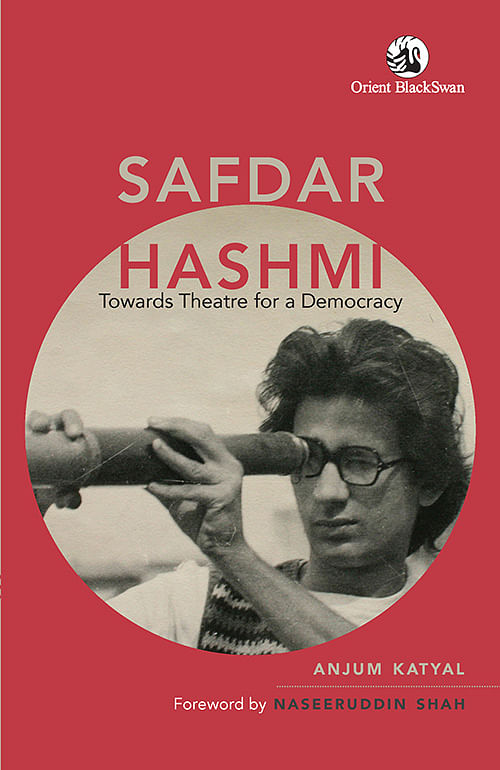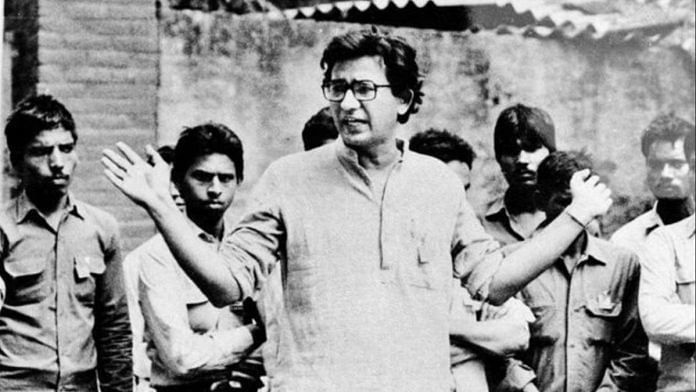The earliest Janam group included Rakesh Saxena, Kajal Das, Subhash Tyagi, Uday Chatterji, Rathin Das, Kajal Ghosh, Shehla Hashmi, and Safdar, along with some others. The first play Janam did, in 1973 itself, was Mrityur Atith, adapted by Utpal Dutt from Bury the Dead by Irwin Shaw. This was in the nature of a fundraiser for the group.
Safdar, in an interview, talks of doing this play (‘The Bengali title meant something like “Beyond Death”’) for the annual Durga Puja celebrations in Delhi, a major social and cultural festive occasion during which a theatre festival is also held. ‘We needed money to start something so that’s why we did this play, making about 5,000 rupees in total. All of us were still students at the time.’
This seed money gave the fledgling group the confidence to plan ahead. They contacted fellow students and soon, according to Safdar, had gathered 50 to 60 people. This included some ‘very highly respected theatre people of Delhi,’ for example, the talented singer Vinod Nagpal, who went on to become an established television and film personality; his wife, theatre actor, director and critic Kavita Nagpal; and the well-known music director and singer Mohan Upreti.
Their next play, done in September the same year, was Bharat Bhagya Vidata (The Architect of India’s Destiny), written specially for them by Ramesh Upadhyaya, and directed by Kavita Nagpal with music composed by Upreti. Safdar played the counter-narrator, while Vinod Nagpal was the narrator.
It was an ironic title and dealt with elections … Mrs Nagpal, who was the director, brought in the characters of the narrator and the counter-narrator … It was a kind of Brechtian device used for comments on the action and through songs we also announced what was going to happen next. We would analyse the scenes.
Safdar describes this as ‘our first major play.’ The production became ‘extremely popular’ in his own words. Not just with audiences; it was well received by the critics too. Janam took the play to college campuses, working class areas, parks, and other public spaces. All in all they gave about 35 performances of it.
In January and February 1974, they went on tour in western Uttar Pradesh, where elections were being held, and performed wherever a CPI or CPI(M) candidate was being fielded, with a clear message, says Safdar: ‘We wanted the people to vote Communist.’
Also read: Safdar Hashmi’s first major play wanted ‘people to vote Communist’. Thousands turned up in UP
Touring in such a context taught Janam how to handle large audiences and unexpected situations. Graphic accounts of makeshift performance areas, unexpected disasters, and adroit adjustments clearly show this.
Rathin Das reminisced amusingly about how a proscenium stage play unexpectedly turned into a street performance when, in Modinagar, they were required to perform on a cobbled-together combination of a bench, table, a vendor’s cart, and a staircase, on a busy thoroughfare, with the headlights of their own bus providing the lighting! Shehla Hashmi, Safdar’s sister, who was touring with them, added that while dancing she had one foot on a level higher than the other; but there was a packed audience nevertheless. Safdar recounts another interesting anecdote from this tour.
They were in a town called Amroha with a population of about 100,000. They were scheduled to perform one night only, and were amazed to find that they had an audience of 15,000 people. ‘We weren’t prepared for such a huge crowd. The stage wasn’t all that high, you see.’
Popular demand led to their staying one more day, and building a higher stage. At this point something amusing happened. Janam was advertising their play through loudspeakers mounted on three rickshaws, which were travelling through the town announcing the time and venue of their performance.
Then they got to know that an ‘extreme rightist political party’ had sent out their own rickshaws telling people not to go see the play because it was obscene, featuring prostitutes and dancing girls from Delhi, sponsored by the Communist Party. ‘So when we heard that we told our rickshaws not to bother because we knew the people were going to come in any case.’ That night 35,000 expectant people turned up!
The situation was chaotic. People could not see or hear and crowds kept pushing and shoving so that at one point there were about 200 audience members on the stage itself. In all the commotion it was impossible to start the play. Safdar found a solution. Vinod Nagpal, the talented singer, was brought on to the stage and asked to sing whatever he wished to.
Safdar describes how this tall, handsome, well-built man came on wearing the clothes he was in—kurta pyjama, with a shawl wrapped round him—and launched into a classical tune, starting with the introductory notes of the alap, then adding lyrics by the revolutionary poet Faiz Ahmed Faiz. Safdar goes on to describe what happened next:
It was as if a spell had been cast on those 35,000 people, many of them women and children. There had been total pandemonium before and now total quiet … So he sang for 35 minutes standing in the middle of the stage … There was a pin-drop silence. When he finished singing the audience went on clapping for a long time. Then we started our play and it went on uninterrupted until well into the morning. I wish I could have filmed that moment.
This was a play with a message, but included ‘dances, songs, and interesting characters’ which made it ‘interesting to perform’, despite being, as Safdar described it, ‘a very schematic play.’ As Janam’s first major play, it is worth looking at in more detail. In terms of storyline, it was set in a ‘small rural constituency’ during elections.
The two leading opposing candidates were a capitalist and a big landlord. Their campaigns targeted and maligned each other, leaving the people confused as to which of these two should get their vote, given that both were exploiters of the common folk. So they decided to field a candidate of their own—a humble cobbler, the lowest of the castes, an ‘untouchable.’
He starts to gain popularity and builds a following, at which the other two, threatened by him, join forces, hire killers, and have him murdered. ‘So the play ends on a note of defeat. The people are totally dejected.’
However, this is where the Brechtian influence makes itself felt. The narrator and the counter-narrator, based on the traditional nat/nati or sutradhar figures, intervene to open up alternate viewpoints within the narrative.
The nat or narrator ‘wants to stick to the story and doesn’t want to get involved in any controversies’ while the counter-narrator, who ‘emerges from the people, says, “It’s not sufficient to tell the people what happened but also why it happened.”’ This is done through song, and later in the play the two narrators ‘merge and sing together’, ending the play with ‘a song to the effect that the struggle continues and that the play only exposes who the enemies are.’
So Janam was already playing with form, bringing in elements from different kinds of theatre traditions, Indian and western, and learning how to adapt to a variety of audiences. They plunged straight into their next play, Bakri, which was also presented in 1974.
Written by Sarveshwar Dayal Saxena, this play was also directed by Kavita Nagpal. According to Qamar Hashmi, till this point, ‘Janam had lacked the confidence to write their own plays … However, with Bakri, things began to change. Dialogues were altered, and some scenes were introduced.
The group gained confidence.’ She notes that by now several well-established Delhi stage actors were associated with Janam, such as Pankaj Kapur, Atiya Bakht, and Anil Chaudhary from NSD. This play was also a musical, and it, too, was greeted with critical acclaim. Safdar describes its hybrid, experimental form, which seemed to be growing into a Janam signature style:
Again the structure fluctuated between a well-made play where realistic scenes alternated with the overall structure of Nautanki, the folk theatre form of Uttar Pradesh and part of Haryana. There was again a nat and a nati and many people who sing and dance. There are many caricatures, dialogues that are sung, etc. It was a very interesting attempt at total theatre.
In keeping with their beliefs, they performed it both indoors and in colleges, working class localities, and rural areas. They did 50 shows in all, a much higher number than the average Delhi theatre production which ran for two or three nights. Safdar feels that ‘we were able to do it because we had an audience that existed beyond the theatre halls, in the working class areas, and because we were working hand in hand with the democratic trade union movement.’
Janam continued performing Bakri till 19 June 1975, just one week before the ruling government declared a state of Emergency throughout the nation. On 12 June, the Allahabad High Court had decreed that Indira Gandhi should vacate her Parliament seat and resign as Prime Minister. She refused and appealed instead to the Supreme Court, which ruled in her favour.
She immediately announced the Emergency, arrested her political opponents, and curbed the freedom of the press. Safdar talks of a foray into street theatre around this time with a ‘short skit Janata Pagal Ho Gai Hai’ (The Public Has Gone Mad). This skit, performed at least 20 times in different areas of the city right until the day Emergency was declared, showed police atrocities against the people. Meanwhile, on Indira Gandhi’s refusal to resign her seat, Janam got the idea to do a skit called Kursi, Kursi Kursi (Chair, Chair, Chair).
 This excerpt from Safdar Hashmi: Towards Theatre for a Democracy by Anjum Katyal has been published with permission from Orient BlackSwan.
This excerpt from Safdar Hashmi: Towards Theatre for a Democracy by Anjum Katyal has been published with permission from Orient BlackSwan.






